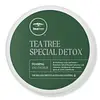What's inside
What's inside
 Key Ingredients
Key Ingredients

 Benefits
Benefits

 Concerns
Concerns

 Ingredients Side-by-side
Ingredients Side-by-side

Sodium Chloride
MaskingWater
Skin ConditioningSea Salt
AbrasiveSodium Methyl Cocoyl Taurate
CleansingSodium Cocoyl Isethionate
CleansingCocos Nucifera Oil
MaskingMelaleuca Alternifolia Leaf Oil
AntioxidantRosa Canina Seed Oil
EmollientVolcanic Sand
Skin ConditioningMontmorillonite
AbsorbentQuartz Powder
AbrasiveTocopherol
AntioxidantGlycine Soja Oil
EmollientEthylhexylglycerin
Skin ConditioningAscorbic Acid
AntioxidantPhenoxyethanol
PreservativeSodium Benzoate
MaskingCitric Acid
BufferingParfum
MaskingLinalool
PerfumingCI 61570
Cosmetic ColorantCI 19140
Cosmetic ColorantSodium Chloride, Water, Sea Salt, Sodium Methyl Cocoyl Taurate, Sodium Cocoyl Isethionate, Cocos Nucifera Oil, Melaleuca Alternifolia Leaf Oil, Rosa Canina Seed Oil, Volcanic Sand, Montmorillonite, Quartz Powder, Tocopherol, Glycine Soja Oil, Ethylhexylglycerin, Ascorbic Acid, Phenoxyethanol, Sodium Benzoate, Citric Acid, Parfum, Linalool, CI 61570, CI 19140
Sucrose
HumectantWater
Skin ConditioningGlycerin
HumectantSodium Lauroyl Isethionate
CleansingCocamide Mea
EmulsifyingPropanediol
SolventGlyceryl Stearate
EmollientPEG-100 Stearate
Silica
AbrasiveSodium Lauroamphoacetate
CleansingSea Salt
AbrasiveHydrolyzed Elastin
EmollientPrunus Amygdalus Dulcis Oil
Skin ConditioningC12-15 Alkyl Benzoate
AntimicrobialPhenoxyethanol
PreservativePEG-150 Distearate
EmulsifyingCocamide Mipa
EmulsifyingParfum
MaskingSodium Benzoate
MaskingTrisodium Ethylenediamine Disuccinate
Caprylyl Glycol
EmollientHexyl Cinnamal
PerfumingLimonene
PerfumingLinalool
PerfumingSucrose, Water, Glycerin, Sodium Lauroyl Isethionate, Cocamide Mea, Propanediol, Glyceryl Stearate, PEG-100 Stearate, Silica, Sodium Lauroamphoacetate, Sea Salt, Hydrolyzed Elastin, Prunus Amygdalus Dulcis Oil, C12-15 Alkyl Benzoate, Phenoxyethanol, PEG-150 Distearate, Cocamide Mipa, Parfum, Sodium Benzoate, Trisodium Ethylenediamine Disuccinate, Caprylyl Glycol, Hexyl Cinnamal, Limonene, Linalool
Ingredients Explained
These ingredients are found in both products.
Ingredients higher up in an ingredient list are typically present in a larger amount.
Linalool is a fragrance and helps add scent to products. It's derived from common plants such as cinnamon, mint, citrus, and lavender.
Like Limonene, this ingredient oxidizes when exposed to air. Oxidized linalool can cause allergies and skin sensitivity.
This ingredient has a scent that is floral, spicy tropical, and citrus-like.
Learn more about LinaloolParfum is a catch-all term for an ingredient or more that is used to give a scent to products.
Also called "fragrance", this ingredient can be a blend of hundreds of chemicals or plant oils. This means every product with "fragrance" or "parfum" in the ingredients list is a different mixture.
For instance, Habanolide is a proprietary trade name for a specific aroma chemical. When used as a fragrance ingredient in cosmetics, most aroma chemicals fall under the broad labeling category of “FRAGRANCE” or “PARFUM” according to EU and US regulations.
The term 'parfum' or 'fragrance' is not regulated in many countries. In many cases, it is up to the brand to define this term.
For instance, many brands choose to label themselves as "fragrance-free" because they are not using synthetic fragrances. However, their products may still contain ingredients such as essential oils that are considered a fragrance by INCI standards.
One example is Calendula flower extract. Calendula is an essential oil that still imparts a scent or 'fragrance'.
Depending on the blend, the ingredients in the mixture can cause allergies and sensitivities on the skin. Some ingredients that are known EU allergens include linalool and citronellol.
Parfum can also be used to mask or cover an unpleasant scent.
The bottom line is: not all fragrances/parfum/ingredients are created equally. If you are worried about fragrances, we recommend taking a closer look at an ingredient. And of course, we always recommend speaking with a professional.
Learn more about ParfumPhenoxyethanol is a preservative that has germicide, antimicrobial, and aromatic properties. Studies show that phenoxyethanol can prevent microbial growth. By itself, it has a scent that is similar to that of a rose.
It's often used in formulations along with Caprylyl Glycol to preserve the shelf life of products.
Sea salt has abrasive or exfoliation properties. It can sensitize and dry out the skin.
Sodium Benzoate is a preservative. It's used in both cosmetic and food products to inhibit the growth of mold and bacteria. It is typically produced synthetically.
Both the US FDA and EU Health Committee have approved the use of sodium benzoate. In the US, levels of 0.1% (of the total product) are allowed.
Sodium benzoate works as a preservative by inhibiting the growth of bacteria inside of cells. It prevents the cell from fermenting a type of sugar using an enzyme called phosphofructokinase.
It is the salt of benzoic acid. Foods containing sodium benzoate include soda, salad dressings, condiments, fruit juices, wines, and snack foods.
Studies for using ascorbic acid and sodium benzoate in cosmetics are lacking, especially in skincare routines with multiple steps.
We always recommend speaking with a professional, such as a dermatologist, if you have any concerns.
Learn more about Sodium BenzoateWater. It's the most common cosmetic ingredient of all. You'll usually see it at the top of ingredient lists, meaning that it makes up the largest part of the product.
So why is it so popular? Water most often acts as a solvent - this means that it helps dissolve other ingredients into the formulation.
You'll also recognize water as that liquid we all need to stay alive. If you see this, drink a glass of water. Stay hydrated!
Learn more about Water